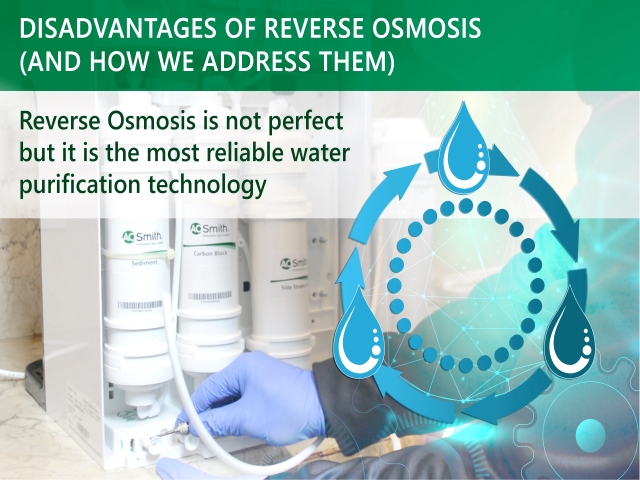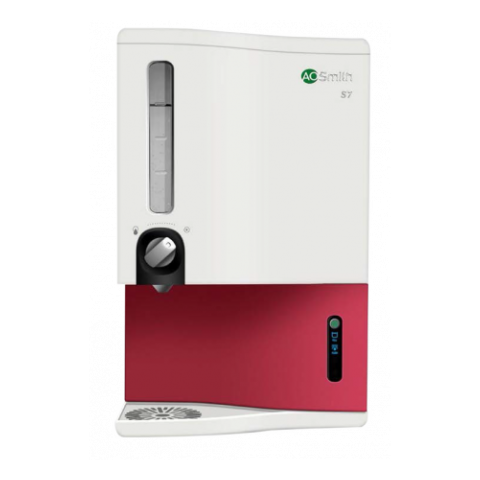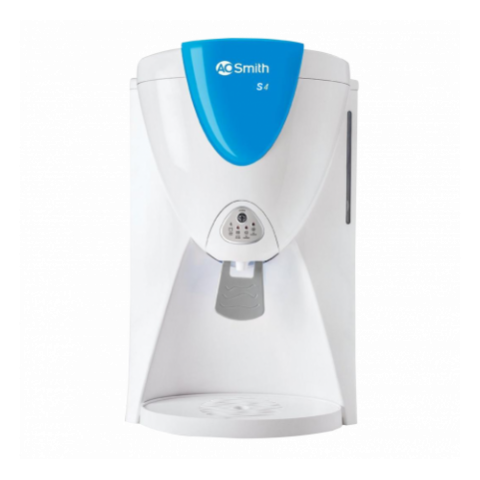What is Reverse Osmosis
Reverse Osmosis, commonly known as RO, is a technology that is used to purify the water by pushing the water under pressure through a semi-permeable membrane. It is a membrane that will allow some atoms or molecules to pass but not the contaminants in the water such as suspended solids, salts, organics and microorganisms. It also contains a sediment filter and a carbon filter in addition to the RO membrane. After water exits the membrane, it passes through a postfilter to polish the drinking water before it enters a dedicated faucet. RO systems have various stages depending on their number of pre-filters and post filters.
RO Disadvantages
Even though RO is considered the best practical water purification technology, it has some disadvantages:
- Reject Water is wasteful
- More expensive
- Removes all minerals, whether healthy or bad
- More difficult installation
Reverse Osmosis wastes a lot of water
Because of the level of purification done using RO, there will be waste or reject water but this rejected water is very small amount compared to what we use for flushing and washing. In fact, water stations usually only recover about 25% of the input water, with 75% rejected. So having your own water purifier doesn't make you waste more water than getting water from water refilling stations.
A. O. Smith has advanced the RO process so that minimum recovery is now at 30%, which is a 20% improvement over conventional RO. However, our latest model like the S600 already recovers 66% of water. This means that for every 1 glass of reject water, you get 2 glasses of purified water. That is more than 100% improvement over conventional RO. So one way of looking at this is, if you use an S600 RO instead of getting water deliveries, you will actually be saving more water!
Still, RO unavoidably has waste water. The best way not to waste that is to collect it for other uses, such as gardening or flushing.
Reverse Osmosis is more expensive
At prices from around 20k and up, RO is considered more expensive than a lot of other water technologies. However, it is the same technology used by most quality water refilling stations that give purified water. It gives purified water with much less energy and cost compared to distilled water. If you look at a peso per liter, water from your own RO purifier will be between 80 centavos to 1.25 pesos per liter, much less than the costs of bottled water or branded water deliveries.
So yes, RO is still more expensive than other filters, but for the quality of water, you actually pay much less.
Reverse Osmosis removes all minerals
Reverse Osmosis systems excel at removing water impurities but one of the major disadvantages of RO systems is that they remove 92-99% minerals from the water such as beneficial calcium and magnesium similar to distilled water. It's a real cost of purified water. A report published by WHO in 1980 stated that low mineral water is not ideal for consumption and on regular consumption as it can result in the deficiency of certain minerals. According to the study, drinking water deficient in calcium or magnesium could lead to fatal health consequences like heart problems. It also stated that drinking water deficient in magnesium can pave way for pregnancy disorders, certain types of cancer and premature death in infants. Meanwhile, drinking water low in calcium can lead to several fractures and growth disorders in children and even low birth weight in certain kids.
There were various health complaints from Czech and Slovak populations who used reverse osmosis water within several weeks or months. Among the complaints mentioned were cardiovascular disorders, tiredness, weakness or muscular cramps that are caused by of acute magnesium (and possibly calcium) deficiency. Water is not the only source of essential minerals like calcium or magnesium. If it really bothers you, it is good to know that we actually get most of our minerals (and vitamins) from the healthy food that we eat. We can ensure a balance by adding green leafy vegetables to our diet. But when scientists performed a study to see if minerals consumed in food can make up for the lack of minerals in RO water, they found out that reduced mineral intake from water was not compensated by people’s diets. Low-mineral water is the only responsible for an increased elimination of minerals from the body.
However, some A. O. Smith RO purifiers like the S7 and A6 address this with an additional MinTech stage. After the RO process, healthy minerals are added back to the water to improve its taste and healthiness, essentially providing purified, mineralized water.
So unless you are severely deficient in minerals, RO water will be safe and healthy. Part of a good, healthy life is drinking a lot of water, eating healthy, having enough sleep, and having regular exercises.
Reverse Osmosis is more difficult to install and maintain
RO purifiers don't come in one stage. Before and after the RO are other purification stages that help clean water and prolong the life of the RO membrane. RO also rejects water, so that water has to go to a drain (or collector tank).
Due to its complexity, RO purifiers are usually harder to install and maintain. A. O. Smith addresses this by providing fast and professional installation and maintenance services to ensure you have continuous supply of pure water. A. O. Smith purifiers also warn you when there is less than 10% of the filter life and stop operating once they reach 0%. This gives you enough time to schedule filter replacements and minimize the inconvenience.
For a family of 3-4, filter replacements are also done either around every 6 months or about once a year so expect to have enough time to enjoy stress-free purified water.
A. O. Smith's latest water purifier, the S600, also goes one step further. The S600 is a tankless model with DIY replacement process. After the initial setup, the S600 makes filter replacement easy for anyone. And you typically only have to do it once a year.
Conclusion
RO is the current gold standard for water purification for drinking and process water. Yes, it has some disadvantages but these are often overblown. That's why it's important to address these disadvantages accordingly. RO is not perfect but it is the most reliable water purification technology we have. Hundreds of million people rely on this technology for safe, drinking water.




